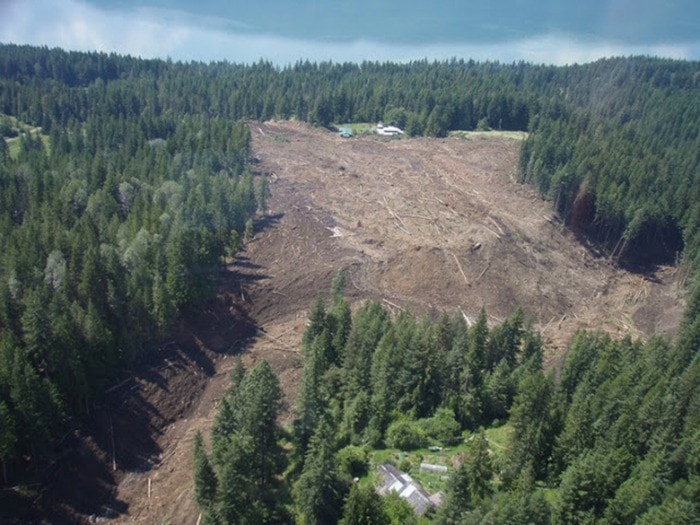More than two years after a deadly landslide at Johnsons Landing, the Regional District of Central Kootenay is poised to rescind an evacuation order for the area, although it probably won't make much difference to affected residents.
Chair John Kettle confirmed the order will be lifted as of Thursday. "It means things can go back to as normal as they can be," he said.
However, that doesn't mean the area is safe — residents are being told that while there is no imminent danger, if they access their land they do so at their own risk. Many have already done so, but to build or rebuild, they will have to provide a geotechnical assessment to the regional district, which Kettle suggested may be expensive and impractical.
The provincial government will continue to monitor the slide area while logging will be restricted on Crown land above the community.
Kettle said the regional district waited for two freshet periods to pass before deciding to lift the order. He is satisfied there has been minimal movement of the slide area in that time.
"It doesn't look like a Doomsday scenario," he said. "It could be tomorrow, it could be 1,000 years from now. But we might also be hit by a car in a crosswalk. We've got to continue to live."
Affected residents were advised of the decision at a meeting Sunday. Kate O'Keefe, whose husband Harvey Armstrong owns a property in the evacuation zone, said there was a "sense of resignation" among the 35 people at the meeting.
O'Keefe said they also learned that a berm on private land put in place following the slide will probably remain in place, although it will require further evaluation.
However, there has been little movement on the issue of compensation. Although the province provided several hundred thousand dollars in disaster assistance to those who lost their primary homes, it hasn't been willing to compensate part-time residents. The government also says it has no means to buy out affected property owners who continue to pay taxes on land they can't use.
"We've had no hope for quite a long time," O'Keefe said. "Our director and John Kettle have done as much as they can possibly do to achieve something, but it leaves a bad taste. People in Calgary [affected by flooding in 2013] were treated differently, and we were basically forgotten."
Rural Kaslo regional director Andy Shadrack said the RDCK has put forward a resolution to the Union of BC Municipalities asking the province to create a compensation program that any property owner affected by a natural disaster could apply to.
While he applauded the province's initial response to the slide, Shadrack said he was "extremely disappointed" it has failed to compensate all affected residents. "It doesn’t seem appropriate to have neighbours side-by-side where one gets compensated and the other doesn’t," he said.
He wasn't impressed either with the regional district's requirement for an engineering report before it allows building in the hazard zone: "If it's not forthcoming, we're going to deny them a permit? That's a terrible situation to put people in."
As it lifted the evacuation order, the regional district issued a warning to residents and property owners advising them of ongoing risks of occupying land in the hazard area. Greg Utzig, whose cabin lies on property partly within that zone, found it perplexing.
"They basically said we’re going to rescind the order and you’re free to do whatever you want on your property but at the same time hand out letters that tell you not to do anything. They're trying to relieve themselves of any responsibility."
A risk assessment concluded 18 properties remain at risk from another slide, including five that face a very high risk. Utzig said he has repeatedly asked for interpretation of the report, giving examples of safe or unsafe activities, to no avail.
He said part of the problem is that the landslide originated on Crown land, which is the province's responsibility, but caused damage on private land, which is the regional district's responsibility.
"A number of us are not very happy but in general I think the regional district has done everything they can do. They certainly tried but the province seems to be missing in action."
He took a dim view of the province's promised monitoring of the slide area, since no details were provided to explain what will be examined, how often, or for how long. Nor were residents consulted.
Ministry of Forests spokeswoman Vivian Thomas said a geomorphologist placed pins at areas above the debris flow to measure movement, which have been monitored regularly, and will continue to be checked for movement.
“Currently the area is relatively stable, but if that changes, that will be communicated immediately to the regional district,” she said.
Four people died when the slide came down on July 12, 2012, destroying five homes as well as a community water system.
Sixteen people were evacuated from seven homes while six residents from three homes chose to stay. Within two weeks of the slide, four evacuated residents returned home. Sixteen residents whose homes were either damaged beyond use or who can’t access their homes remain under the evacuation order.
Under provincial legislation, such orders can't remain in place indefinitely.
The regional district says the instability of the slide area is "consistent with what can be expected" however its significance can't be determined because there is no data to compare it to. It also says geotechnical experts advise against trying to bring down the slide debris through controlled means.
Although the evacuation order has been lifted, portions of three roads remain closed.
